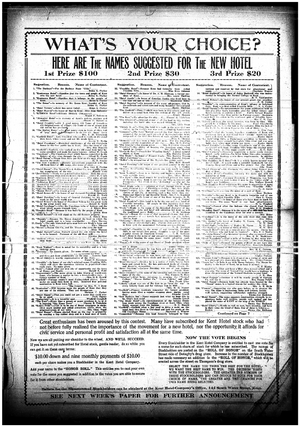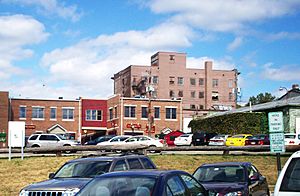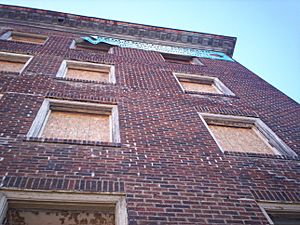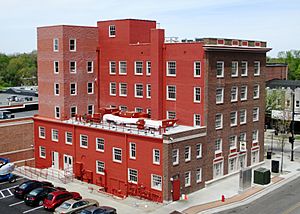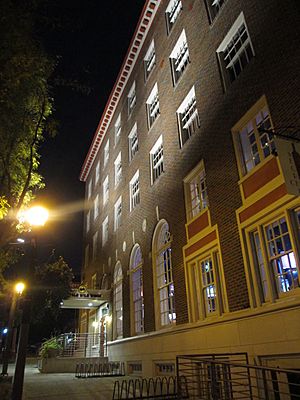Franklin Hotel (Kent, Ohio) facts for kids
Quick facts for kids |
|
|
Franklin Hotel
|
|
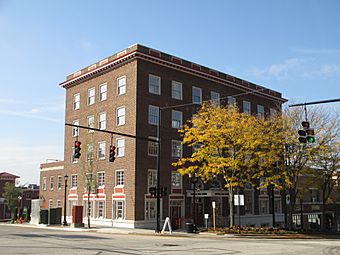
Front in October 2013
|
|
| Location | 176 E. Main St., Kent, Ohio, U.S. |
|---|---|
| Built | 1919–20 |
| Architect | H.L. Stevens |
| Architectural style | Neoclassical |
| NRHP reference No. | 12000802 |
| Added to NRHP | January 18, 2013 |
Acorn Corner is a six-story historic building in Kent, Ohio. It was originally known as the Franklin Hotel. This building has been listed on the National Register of Historic Places since January 2013.
Construction of the hotel began in 1919. It officially opened its doors in September 1920. Over the years, it was also called the Hotel Kent and later the Hotel Kent-Ellis. Many locals simply called it the "old Kent hotel." The building operated as a hotel until the early 1970s. Then, it was changed into housing for students.
In 1979, the top four floors were declared unsafe. However, the lower floors continued to house small businesses until 2000. After being empty for several years, the building was bought in late 2011. A local developer named Ron Burbick purchased it. He renamed it Acorn Corner to match his nearby Acorn Alley project.
A big renovation project began, costing $6.5 million. This work included building a new elevator shaft. The newly renovated building opened in April 2013. Many people called it a "Kent miracle." Today, it houses a Buffalo Wild Wings restaurant, a wine bar, offices, and apartments. The building was designed by architect H.L. Stevens. It shows the Neoclassical Revival style.
Contents
Building a New Hotel in Kent
The idea to build a new hotel in Kent started in the early 1900s. The Kent Board of Trade, now called the Kent Chamber of Commerce, led this effort. Kent already had two places to stay, but they were not very big. The previous main hotel, the Revere Hotel, had closed in 1899.
Business leaders felt a larger, modern hotel was needed. This was because industries were growing. Also, more people were traveling by train. Plus, Kent State Normal College was just starting. Dudley Mason, who owned Mason Tire and Rubber in Kent, first suggested the idea.
Finding a Name and Location
To raise money, they started selling shares of stock on March 24, 1919. During this time, the Board of Trade held a naming contest. It was in the local Kent Courier newspaper. The name "Franklin Hotel" won the contest. It was chosen because Kent used to be called Franklin Mills.
In August 1919, the first loan was secured. The next month, an architect was chosen. The Barnett property was picked as the building site. It was at the corner of East Main and South DePeyster Streets. The old Barnett home was torn down. Digging for the foundation started by September 11, 1919. The walls began to go up by December 18.
Opening and Early Years
The hotel opened for tours on September 8 and 11, 1920. These tours were for stockholders and their families. The public opening was on September 12, 1920.
Even with good reviews, the Franklin Hotel often struggled with money. It changed owners and managers many times. By 1934, it had been sold at auction twice. Many early investors lost their money.
The Hotel Kent Era
Florence B. Adams bought the building in 1934. She was from Kent Hotel Incorporated. She renovated it, and it reopened in 1937 as the Hotel Kent. From 1937 to the mid-1950s, Russell O'Conke managed the hotel. This time is seen as its best period. The hotel was financially stable. It was advertised as "Ohio's Most Modern Hotel." It was also called "Ohio's Finest Small Town Hotel."
Many famous people stayed at the hotel during these years. These included bandleader Guy Lombardo and pilot Amelia Earhart. Musician Glenn Miller also visited. Eliot Ness, a famous lawman, often went to the hotel's bar in the 1940s. Martin L. Davey, who was the Governor of Ohio in the 1930s and from Kent, had an office there.
Decline of the Hotel
In 1956, a new motel opened nearby. It was called the Eastwood Motor Inn. This new motel had modern features like lots of parking and air conditioning. The Hotel Kent did not have these. Also, fewer people were traveling by train. More people were using cars. This meant less need for hotels like the Franklin.
In 1962, Frank Ellis took over management. The hotel was renamed Hotel Kent-Ellis. But its financial problems continued. Two more modern motels opened in Kent. These were the Motor Inn in 1964 and the University Inn in 1970.
By the 1970s, the building was in bad shape. Hotel operations were no longer making money. It was sold to Joseph Bujack. He changed it into student housing, calling it the Towne House. Fires and general decay led the city to close the upper floors in January 1979. Those floors stayed empty until 2013. The lower floors were still used by small businesses until 2000. These included a pizza shop, a cafe, and nightclubs.
The Building's Struggles
In 1999, people complained about roof damage. The city checked the building. They found that parts of the brick outside were loose. This was dangerous for people walking by. Inspectors also found many health and safety problems. The city tried to close the whole building.
An agreement was made in October 1999 to fix things. But only small repairs were done. These included fixing some bricks, the roof, and windows. This stopped pigeons from getting into the upper floors. In March 2000, the last businesses in the building closed. The city told the owner, Bujack, to decide if he would fix or tear down the building. He decided to tear it down, but no work ever started.
Attempts to Save the Building
In March 2002, Bujack was ordered by a court to tear down the building. If he didn't, he would be fined $1,000 each day. Bujack offered to give the building to a local service group. They wanted to fix it up for apartments and shops. But the city decided not to take the building. They felt it was too risky. Other groups also showed interest. Some wanted to make it a hotel again. Others wanted to build a new store. But none of these plans worked out.
In 2004, Greg Vilk bought the old hotel. He used to run the last businesses in the building. Vilk had sued the previous owner and got the building as part of a deal. At that time, the previous owner owed over $308,000 in fines on the building. Vilk and his group, Kent LLC, planned to fix up the building. But their plans never happened.
In 2007, Vilk was ordered to make safety repairs. He cleaned the bricks and fixed some loose ones. He also removed some windows and painted the back wall. Inside, much of the building was emptied out. This was to make it look better for possible buyers. However, concerns were raised about getting government grants for old buildings. So, no more renovation work was done. The building continued to get worse. People called it an "eyesore" and wanted it torn down.
A New Beginning: Redevelopment
In 2006, the Kent City Council thought about taking over the building and tearing it down. They decided not to tear it down. But they did try to take ownership. For several years, Vilk and the city argued about fines and fixing the building. Vilk said the city had promised to remove the fines. A court ruling in 2007 stopped new fines. But the old fines, totaling $425,000, remained.
In 2008, Vilk sued the city. He wanted $25,000 and the fines removed. In 2009, a judge ruled that the city could not collect the fines. The judge said the county was in charge of them. Later in 2009, courts ruled that neither the city nor the county had any fines on the property. But the court fines for not following orders still stood. Vilk argued these fines were for the old owner and were no longer active.
A deal was reached in 2011. The city bought the building for $735,000. A few days later, they sold it to Ron Burbick for $400,000.
The Phoenix Project and Acorn Alley
Before buying the old hotel, Ron Burbick had funded the Phoenix Project. This project fixed up two nearby downtown buildings. It also tore down a house next to the old hotel. In its place, Burbick built a shopping area called "Acorn Alley." Acorn Alley opened in late 2009 and quickly became popular. The new development made the old, run-down hotel stand out even more.
The Phoenix Project also encouraged more building in downtown Kent. Several big projects, costing nearly $100 million, started in 2010. These included a second part of Acorn Alley. There was also a new hotel, a parking garage, and more shops and offices. All of these were very close to the old hotel.
Soon after buying the building, Burbick announced his plans. He would renovate the building for different uses. The lower floors would have shops and offices. The top two floors would have apartments. In April 2012, the first tenants were announced. Buffalo Wild Wings would be on the first and second floors. There would be luxury apartments on the fifth floor. Offices would be on the third floor. Retail shops would be in the basement.
Burbick also said the building would be renamed "Acorn Corner." This was to go with the nearby Acorn Alley.
Renovation and Reopening
Small renovation work started in May 2012. This included removing asbestos and lead paint. Then, outside brick work began on May 22, 2012. The entire brick front was cleaned and re-grouted. More major work inside started in September.
In October, construction began on a new elevator shaft. A new stairwell was also added to the back of the building. The old elevator shaft was too small for modern elevators. Buffalo Wild Wings opened on April 1, 2013. Other tenants moved in later in April and May. The local Record-Courier newspaper called the renovation a "Kent miracle." They said it brought the building "back from the dead."
What's Inside Acorn Corner Today?
As of 2013, the building has several businesses and homes. Buffalo Wild Wings is the main tenant. It takes up the first and second floors. This restaurant chain even mentions Kent in its company history. It helped pay for the renovation. The restaurant uses the original hotel lobby area.
In the basement, there is the Franklin Hotel Bar. It opened in December 2016. It offers special drinks, small food plates, fine wines, and craft beers. Before that, a wine and jazz bar called the Secret Cellar was there. On the third floor are offices for Marathon Financial Services. The Kent Chamber of Commerce also has an office there. They used to have an office in the building in the 1920s. The fourth and fifth floors are private apartments.
Building Style
The Franklin Hotel was designed by H.L. Stevens & Company. This architectural firm had offices in Chicago, New York, and San Francisco. The Stevens firm had designed other similar hotels before. One example is the Hotel Ashtabula in Ashtabula, Ohio. Many other buildings designed by Stevens are also listed as historic places.
Like several other Stevens buildings, the Franklin Hotel has a brick front. It is designed in the Neoclassical Revival style. This was a popular building style in the early 1900s. The building has about 22,000 square feet of space. It has six levels in total. Five are above ground, and one is a partially exposed basement. The basement is partly visible because the ground slopes.
Becoming a Historic Landmark
After buying the building, Ron Burbick started the process to get it added to the National Register of Historic Places (NRHP). This would help him get about $2 million in grants and tax breaks. These funds would help pay for the renovation. The renovation was first expected to cost around $4 million. To help with this, the city of Kent created a historic district in March 2012. This district included only the hotel. The National Park Service officially added the old hotel to the NRHP on January 18, 2013. The final cost of the renovation was $6.5 million.
Restoration Requirements
To get the historic preservation grants, certain parts of the building had to be restored. There were rules for new windows, signs, and inside work. Any new changes to meet modern building rules had to look different from the original parts.
One required restoration was a large painted sign on the west side of the building. This side faces downtown Kent. It was painted in the same spot as older versions of the sign. These signs had been visible before the bricks were cleaned in 2012.
The building's first elevator shaft was too small for a modern elevator. So, a new shaft was built onto the back of the building. A new stairwell was also added. The rules for historic restoration said the outside of the new shaft had to be a different color. This was to show it was not part of the original building. Its location on the southwest corner followed rules from the National Park Service. The old elevator shaft is now used for electrical wires and pipes.
Also, one of the original entrance doors on East Main Street had to be restored. But it could not be used as an entrance. This was because a ramp was needed for the building to follow the Americans With Disabilities Act (ADA).
Burbick had planned to use parts from the old Gougler Industries offices. These offices were from the same time period as the hotel. The owner of the Gougler buildings donated the items in 2011. This was after the Gougler buildings were torn down. However, historic preservation rules said he could not use materials from one old building to restore another. So, the woodwork was used to create a display about Gougler Industries in Acorn Corner. It was also used in a conference room in the nearby Acorn Alley II building.
Why It's Historic
The Franklin Hotel was nominated for the National Register of Historic Places because of its importance to Kent's history. It is important for its role in business and community development. This is because the business community worked together to build it. It is also important for its connection to key government and business leaders in the history of Kent. It also played a part in the early growth of Kent State University.




